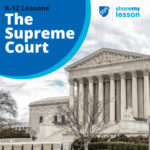What is the nomination process for Supreme Court justices and federal judges? Find out in a multimedia package of educational resources geared to high school students, their teachers, and interested adults. What do judges promise in the judicial oath of office? What is the role of justices and judges? What kinds of information are nominees asked to share during the nomination process? What do judges, themselves, say about what it means to be impartial?
Moments in History: Remembering Thurgood Marshall
Few people know the legal mind of justices or judges as well as the law clerks who have worked with them. Justice Thurgood Marshall’s former law clerks offer unique insights into the character, values, and thought processes of the first African American to serve on the Supreme Court of the United States. In this 8.5-minute video called “Moments in History: Remembering Thurgood Marshall,” prominent lawyers reminisce about the examples of compassion and courage they saw in the life and work of this legal legend.
Article III: The Judicial Branch
Article III establishes the judicial branch of government, which is responsible for interpreting the laws. At the highest level, the judicial branch is led by the U.S. Supreme Court, which today consists of nine justices. In the federal system, the lower courts consist of the courts of appeals and the district courts. Learn more about judicial independence and judicial review in the National Constitution Center’s learning module.
The Appointment of Sandra Day O’Connor
The U.S. Constitution grants the President the power to appoint people to a variety of government positions. These appointments require careful thought and consideration since the people can have a great impact on the lives of many Americans during that President’s term. Some appointments need even greater thought and consideration, and those are to the federal judicial system and more importantly, to the Supreme Court of the United States. Justices of the Supreme Court (and other federal courts) serve lifetime appointments. Their rulings as they interpret the Constitution, and other situations as outlined in Article III of the Constitution, can have far-reaching effects for generations. With this awesome power to appoint comes an equally awesome responsibility to make sure that the individuals are the best people for the job. In this lesson, students will examine the appointment of Supreme Court Justice Sandra Day O’Connor, who was also the first female Justice. Students will examine the process by which a President makes the selection and the steps that lead to that person being confirmed by the Senate (or not).
3 Must-Have Supreme Court Nomination Documents
“3 Must-Have Supreme Court Nomination Documents” looks at President Ronald Reagan’s appointment of Supreme Court Justice Antonin Scalia in 1986. Primary Source A outlines the suggested qualities of an ideal candidate for President Reagan to nominate to the Supreme Court. Primary Source B provides a Memo to the President from Peter J.
Wallison, Counsel to the President, in which Wallison provides background information with a few potential questions for both Justice Rehnquist and Judge Scalia. Primary Source C is a transcript from President Reagan’s August 9, 1986, Radio Talk on the appointment of the Supreme Court Justices. Each of these documents showcase the amount of thought and consideration the president must take when nominating a Supreme Court Justice.
Historic Supreme Court Cases
Students will learn about historic Supreme Court cases and the process of bringing a case to the Supreme Court. They will read arguments and discover the importance of this third branch of government. Students will discover the changes these cases made in the lives of people. From the knowledge they gain, students can determine how the outcome may have affected their lives.
Supreme Court Cases On Display
The purpose of this lesson is to have students working in groups of two or three focus of one historic Supreme Court case. Students will understand the process of bringing a case to the Supreme Court, read arguments and discover the importance of this third branch of government. Students will discover the changes these cases made in the lives of people. Then students can determine how the outcome may have affected their lives.
Use Constituting America’s Constitution Archives on U.S. Supreme Court Cases and Justices to support this lesson.
The Supreme Court: Balancing the Branches

The nine, lifetime-appointed justices on the Supreme Court play a huge role in our lives through interpreting the application of laws passed by the United States Congress and state legislatures. The Share My Lesson team has curated a collection of free lesson plans and activities to support teachers in educating their students about the structure and role of the Supreme Court.
The 19th Amendment: A Woman’s Right to Vote
Voting is the most basic right of a citizen and the most important right in a democracy. When you vote, you are choosing the people who will make the laws. For almost a century and a half of our nation’s history, women were barred from exercising this fundamental right. This film explores the long, difficult struggle for women to win the right to vote. It’s about citizenship, the power of the vote, and why women had to change the Constitution with the 19th Amendment. The film includes primary sources and commentary from historians, legal scholars, and Justices Ruth Bader Ginsburg and Anthony Kennedy.
When National Security Trumps Individual Rights
On December 18, 1944, the U.S. Supreme Court handed down one of its most controversial decisions when it upheld the government’s decision to intern all persons of Japanese ancestry (both alien and nonalien) on the grounds of national security. Over two-thirds of the Japanese in America were citizens and the internment took away their constitutional rights. In this lesson, students evaluate the consequences of past events and decisions related to the Supreme Court case Korematsu v. United States (1944). They consider the challenges involved when trying to balance civil liberties and national security during threatening times and reflect on the lessons learned about civil liberties from the justices in the Korematsu case.